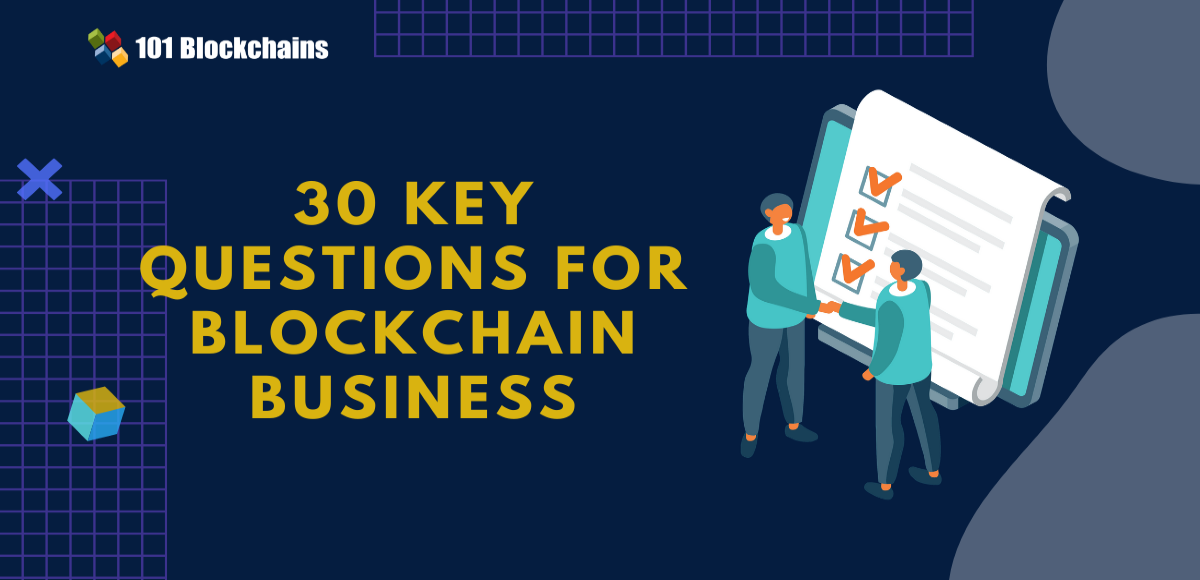Learn how blockchain truly works, master key definitions, and uncover what makes smart contracts so "smart." Dive into the fundamentals, gain valuable insights, and start your blockchain journey today!

- Opinions
Diego Geroni
- on January 05, 2022
Future of Blockchain: Predictions for 2022 [UPDATED]
Wondering what would be the future of blockchain? Check out these top Blockchain predictions for 2022 and get yourself future-ready!
The recent year has been a top-notch platform for evoking popularity around the distributed ledger technology, otherwise known as the blockchain. The global pandemic has given a formidable boost to trends that were already in place. Enterprises are investing more in pure R&D projects for achieving blockchain initiatives with better pragmatism and realism.
With a global event like the recent pandemic, it is reasonable to wonder about blockchain’s future in 2022. Blockchain has been a crucial player in driving the digital transformation required for accommodating the sudden rise in remote work settings. Since blockchain technology has been rightly touted as the technology of the future, it is important to focus on blockchain future predictions.
Build your identity as a certified blockchain expert with 101 Blockchains’ Blockchain Certifications designed to provide enhanced career prospects.
What would be the Future of Blockchain Technology?
With many industries going through massive makeovers in response to the changes in the business environment, many blockchain enthusiasts and onlookers are worried about the future prospects for blockchain. The following discussion reflects some of the notable trends that could dictate the blockchain industry’s potential state in 2022.
-
Blockchain and Governance Applications will Increase
One of the foremost trends that could dominate the future of blockchain in 2022 is the integration of blockchain in government agencies. The Finance Minister of Japan has recently recognized blockchain technology as an essential component in fighting continuously against the global pandemic. Government authorities in Columbia have also presented promises for supporting cryptocurrency and blockchain-based payment systems.
South Korea has been successful in bringing more than a million driver’s licenses on a blockchain-based system. Thailand is also planning on the introduction of a new juridical document storage solution based on blockchain. Furthermore, Vietnam has successfully adapted the use of akaChain, a dedicated blockchain platform, for the better digital transformation of the country.
Most important of all, China is preparing to issue a completely virtual cryptocurrency, with China being a prominent player in the world economy and politics. At the same time, blockchain can penetrate people’s day-to-day lives, thereby characterizing business knowledge in blockchain as an important soft force in international diplomacy. In addition, the use of blockchain in voting systems will also continue to be one of the notable trends in the future of blockchain.
-
More Blockchain in Retail
2022 will obviously witness a large-scale rise in blockchain’s introduction in the retail sector for supply chain and inventory management capabilities. Starting in 2016, the collaboration of IBM and Walmart established the first step for bringing blockchain and retail together on the same page. As a result of the collaboration, the Food Trust blockchain emerged as the solution for tracking food products. Most recently, IBM has introduced a trade solution for freight management known as Tradelens in 2018 in partnership with Maersk.
The benefits of blockchain for the retail sector, especially notable players like Walmart, spell good news for blockchain’s future. Walmart has been able to utilize the blockchain platform for tracking their shipping alongside payment for around 70 shipping companies alongside multiple retailers. Other notable examples of the adoption of blockchain in the retail sector include Nestle, Amazon, Volvo, and Ford. Volvo and Ford’s notable automobile manufacturers leverage blockchain solutions for tracking the supply of cobalt used for lithium-ion batteries.
Nestle is presently running a pilot project based on blockchain for tracking the origin of baby milk and coffee. Amazon has been able to leverage blockchain solutions for controlling the supply of wine. Therefore, the blockchain predictions for 2022 primarily point out wide-ranging levels of inclusion. With almost $600 million in blockchain projects invested last year, blockchain’s future trends hold promises for rising investments.
-
Most Projects Will Approach Production
The next important prediction for the future of blockchain for the next year points out to the fact that around 30% of blockchain projects worldwide will reach production stages. The realistic and pragmatic approaches to blockchain projects will be a primary driving factor for achieving this feat.
In addition, the requirement of faster time to market due to the pandemic and faster initiation of projects could also speed up blockchain projects towards production in limited timeframes. Furthermore, it is also expected that a major share of the networks that would shift from pilot to production would operate on enterprise blockchain platforms.
Start your blockchain journey Now with the Enterprise Blockchains Fundamentals
-
China Will Dominate Blockchain Space, Probably
The domination of China in the field of blockchain will also be one of the top predictions for the future of blockchain. China has included blockchain in the ‘new infrastructure’ initiative that focuses on the country’s digital infrastructure. The Chinese government plans to increase investments in the majority of provinces across different verticals.
Therefore, it is reasonable to expect a steady rise in the number of systems going into the production stage. However, the existing geopolitical scenario does not present adequate promises for the expansion of China’s global Blockchain Service Network. On the other hand of the spectrum, the European Blockchain Services Infrastructure (EBSI) also holds a prominent grip. Although EBSI can find explicit progress with pilot projects, it cannot achieve any major groundbreaking results due to conflicting interests and highly convoluted procurement processes.
-
DeFi Will Continue to Increase
Many industry leaders have been open to the prospects of public blockchains in enterprise contexts regarding blockchain’s future. However, the introduction of DeFi has the potential for turning the attention away from public blockchains towards permissioned blockchains.
The total value of cryptocurrencies invested in Ethereum smart contracts in the early part of 2020 has crossed over $10 billion in such a short period of time. Although this figure does not imply the amount invested by people in DeFi bets, it shows users’ interest in the bets. Therefore, one can clearly notice the continuously and steadily accelerating interest in DeFi.
In the future, the number of transactions beyond conventional mechanisms and medium would increase substantially. So, blockchain transactions can approach a particular inflection point where businesses, regulators, and political leaders would focus on DeFi.
Want to know more about DeFi? Enroll Now: Introduction to DeFi Course
-
Use of Blockchain for Social and Political Objectives
The application of blockchain in social and political activities could gain recognition among potential trends for the future of blockchain. Blockchain has been associated with the potential for transformation of supply chain management, reduction of identity theft, or digital rights management.
The primary elements in the blockchain that foster its applications in these areas include transparency and trust. Keeping in line with the same elements, blockchain technology applications for fighting misinformation gained attention in 2020. For example, the R&D team of The New York Times developed a prototype program for recording all activities with a photograph as metadata. Then, the program would display the information to users on their social media feeds.
As a result, the wider adoption of blockchain solutions can help in establishing better claim over photos and other content. With the rising use of blockchain technology, blockchain predictions for 2022 paint blockchain as an emerging tool for social change.
-
Interoperability with Traditional Banking and Financial Organizations
The future of blockchain in 2022 will also witness the interoperability of blockchains with conventional financial and banking organizations. Users are showcasing more trust in blockchain as compared to traditional banks. Therefore, banks are also increasingly adopting blockchain as a measure to reach out to their customers’ trust. So, 2022 will obviously witness continuity in this trend, with many notable names already diving into the use of blockchain.
JP Morgan presently uses blockchain for addressing automated margin payments. Northern Trust is presenting leveraging blockchain to test the trading of fractional bonds for retail investors. Santander has redeemed a $20 million-worth bond issued on the blockchain. Most important of all, HSBC has executed two letters of credit transactions on a blockchain between companies in the Gulf.
-
New Projects Will Have a Tough Competition
There has been a considerable boost in the development of blockchain solutions. However, it does not dictate that the future of blockchain would have multiple applications within no time. The problems with some public blockchain networks recently showcase the need for reflecting on the state of the blockchain market in 2022.
First of all, EOS had issues with network centralization and congestion. Subsequently, the postponed updates for the Ethereum network have resulted in problems with smart contracts’ performance. Another example of blockchain platforms’ issues is TRON, which has been facing heat over critical code vulnerabilities.
Therefore, the public blockchain market will obviously witness steady growth in competition without any signs of subsiding. In such cases, the projects could be successful only if they are successful in resolving internal conflicts. Furthermore, new blockchain projects in 2022 will have to take new approaches to using blockchain technology into consideration.
Aspiring to make a lucrative career as a blockchain engineer but not sure how? Check the detailed guide Now on How To Become A Blockchain Engineer
Final Words
The year 2020 is about the end and is definitely a clarion call for reflecting on the possible future of blockchain. As evident from this discussion, blockchain trends for 2022 showcase multiple promises. Simultaneously, the predictions for blockchain in 2022 also bring attention to setbacks that require immediate attention. Understanding blockchain industry trends and reviewing the expected future trends can help with better results in a blockchain career.
Furthermore, staying updated with industry trends is also a helpful booster for students aspiring for blockchain certifications. On a concluding note, you can clearly notice blockchain’s potential for dominating the technology sector in the future. Not to mention, the importance of Blockchain certifications will increase subsequently in 2022, so if you want to have a bright career, choose one of the best blockchain certifications and become a Certified Blockchain professional to get future-ready.
*Disclaimer: The article should not be taken as, and is not intended to provide any investment advice. Claims made in this article do not constitute investment advice and should not be taken as such. 101 Blockchains shall not be responsible for any loss sustained by any person who relies on this article. Do your own research!






